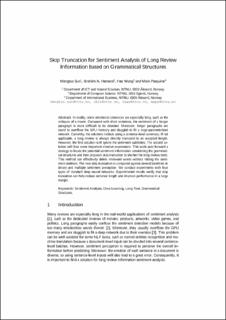| dc.contributor.author | Sun, Mengtao | |
| dc.contributor.author | Hameed, Ibrahim A. | |
| dc.contributor.author | Wang, Hao | |
| dc.contributor.author | Pasquine, Mark | |
| dc.date.accessioned | 2023-03-14T12:50:18Z | |
| dc.date.available | 2023-03-14T12:50:18Z | |
| dc.date.created | 2022-05-15T11:18:10Z | |
| dc.date.issued | 2022 | |
| dc.identifier.citation | Lecture Notes on Data Engineering and Communications Technologies. 2022, 113 298-308. | en_US |
| dc.identifier.issn | 2367-4512 | |
| dc.identifier.uri | https://hdl.handle.net/11250/3058166 | |
| dc.description.abstract | In reality, some emotional utterances are especially long, such as the critiques of a movie. Compared with short sentences, the sentiment of a longer paragraph is more difficult to be detected. Moreover, longer paragraphs are eased to overflow the GPU memory and sluggish to fit a large-parameterized network. Currently, the solutions include using a sentence-level summary; if not applicable, a long review is always directly truncated to an accepted length. However, the first solution will ignore the sentiment subtleties; The second solution will lose some important emotive expressions. This work puts forward a strategy to locate the potential sentiment information considering the grammatical structures and then proposes skip truncation to shorten the long review texts. This method can effectively delete irrelevant words without hitting the sentiment skeleton. The new skip truncation is compared against several baselines in binary and multiple sentiment perception. We conduct experiments with four types of standard deep neural networks. Experimental results verify that skip truncation can help reduce sentence length and improve performance in a large margin. | en_US |
| dc.language.iso | eng | en_US |
| dc.publisher | Springer | en_US |
| dc.title | Skip Truncation for Sentiment Analysis of Long Review Information Based on Grammatical Structures | en_US |
| dc.title.alternative | Skip Truncation for Sentiment Analysis of Long Review Information Based on Grammatical Structures | en_US |
| dc.type | Peer reviewed | en_US |
| dc.type | Journal article | en_US |
| dc.description.version | acceptedVersion | en_US |
| dc.source.pagenumber | 298-308 | en_US |
| dc.source.volume | 113 | en_US |
| dc.source.journal | Lecture Notes on Data Engineering and Communications Technologies | en_US |
| dc.identifier.doi | 10.1007/978-3-031-03918-8_27 | |
| dc.identifier.cristin | 2024652 | |
| cristin.ispublished | true | |
| cristin.fulltext | original | |
| cristin.fulltext | original | |
| cristin.qualitycode | 1 | |
